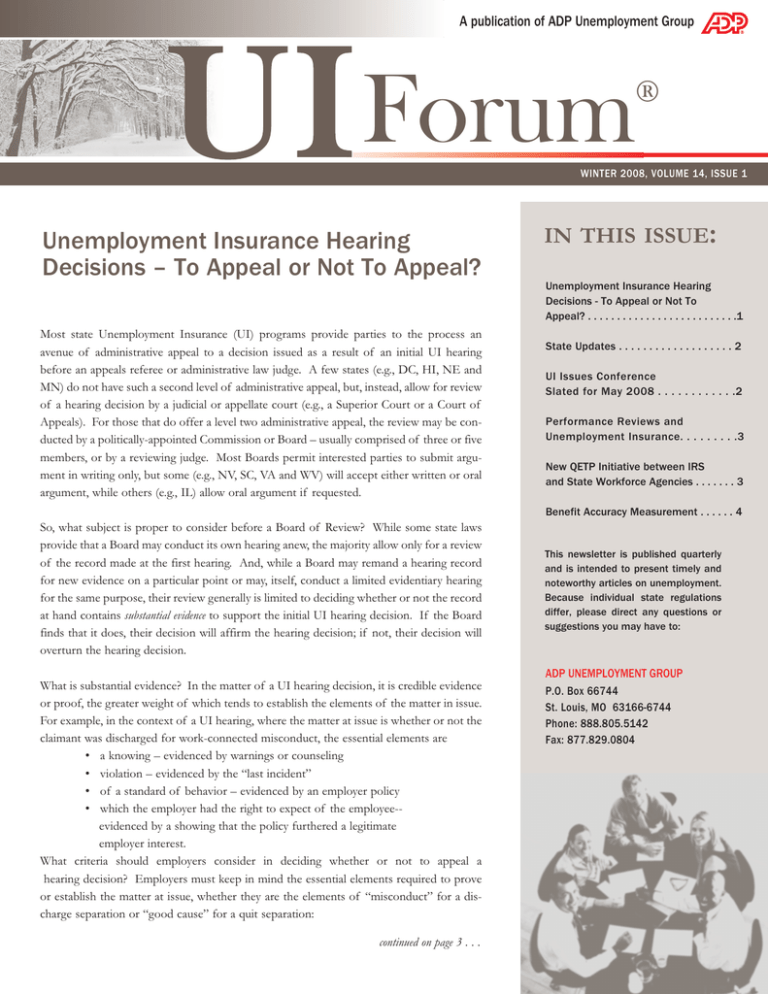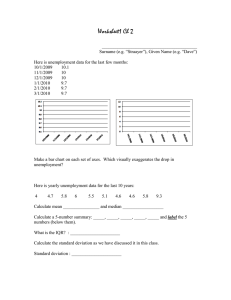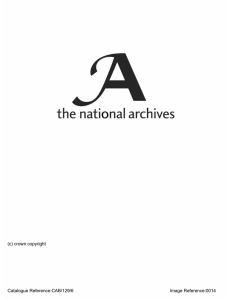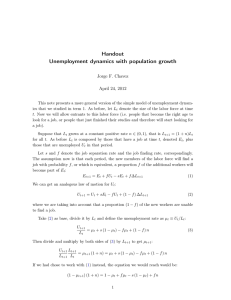
U I Forum
A publication of ADP Unemployment Group
®
WINTER 2008, VOLUME 14, ISSUE 1
Unemployment Insurance Hearing
Decisions – To Appeal or Not To Appeal?
Most state Unemployment Insurance (UI) programs provide parties to the process an
avenue of administrative appeal to a decision issued as a result of an initial UI hearing
before an appeals referee or administrative law judge. A few states (e.g., DC, HI, NE and
MN) do not have such a second level of administrative appeal, but, instead, allow for review
of a hearing decision by a judicial or appellate court (e.g., a Superior Court or a Court of
Appeals). For those that do offer a level two administrative appeal, the review may be conducted by a politically-appointed Commission or Board – usually comprised of three or five
members, or by a reviewing judge. Most Boards permit interested parties to submit argument in writing only, but some (e.g., NV, SC, VA and WV) will accept either written or oral
argument, while others (e.g., IL) allow oral argument if requested.
So, what subject is proper to consider before a Board of Review? While some state laws
provide that a Board may conduct its own hearing anew, the majority allow only for a review
of the record made at the first hearing. And, while a Board may remand a hearing record
for new evidence on a particular point or may, itself, conduct a limited evidentiary hearing
for the same purpose, their review generally is limited to deciding whether or not the record
at hand contains substantial evidence to support the initial UI hearing decision. If the Board
finds that it does, their decision will affirm the hearing decision; if not, their decision will
overturn the hearing decision.
What is substantial evidence? In the matter of a UI hearing decision, it is credible evidence
or proof, the greater weight of which tends to establish the elements of the matter in issue.
For example, in the context of a UI hearing, where the matter at issue is whether or not the
claimant was discharged for work-connected misconduct, the essential elements are
• a knowing – evidenced by warnings or counseling
• violation – evidenced by the “last incident”
• of a standard of behavior – evidenced by an employer policy
• which the employer had the right to expect of the employee-evidenced by a showing that the policy furthered a legitimate
employer interest.
What criteria should employers consider in deciding whether or not to appeal a
hearing decision? Employers must keep in mind the essential elements required to prove
or establish the matter at issue, whether they are the elements of “misconduct” for a discharge separation or “good cause” for a quit separation:
continued on page 3 . . .
IN THIS ISSUE:
Unemployment Insurance Hearing
Decisions - To Appeal or Not To
Appeal? . . . . . . . . . . . . . . . . . . . . . . . . . .1
State Updates . . . . . . . . . . . . . . . . . . . 2
UI Issues Conference
Slated for May 2008 . . . . . . . . . . . .2
Performance Reviews and
Unemployment Insurance. . . . . . . . .3
New QETP Initiative between IRS
and State Workforce Agencies . . . . . . . 3
Benefit Accuracy Measurement . . . . . . 4
This newsletter is published quarterly
and is intended to present timely and
noteworthy articles on unemployment.
Because individual state regulations
differ, please direct any questions or
suggestions you may have to:
ADP UNEMPLOYMENT GROUP
P.O. Box 66744
St. Louis, MO 63166-6744
Phone: 888.805.5142
Fax: 877.829.0804
2
UI FORUM®
State Updates
AK – Two bills in Alaska, SB 120 and HB 59, introduced
in the last legislative session, will be carried over to the
session beginning January 15, 2008. They propose to
increase the state’s maximum weekly unemployment insurance benefit amount from $248 to $370 and to tie subsequent changes to an economic indicator not to exceed
50% of the state’s average weekly wage from the prior calendar year.
HI – The weekly unemployment insurance weekly benefit
amount increased effective January 1, 2008, from $475 to
$523. The minimum weekly benefit amount remains $5.
Legislation passed last session changed the formula for
calculating the maximum weekly amount to 75% of the
state’s average weekly wage for the benefit years beginning
January 1, 2008 through December 31, 2010.
LA – House Bill 345 became law on June 22, 2007. Currently, experience-rated employers who report 250 or
more employees in any calendar quarter must file their
contribution and wage reports on a magnetic medium.
Employers with fewer than 250 employees may elect to use
magnetic reporting and the employers who do not elect
magnetic reporting file on hardcopy. This bill authorizes
the secretary by administrative rule to require employers
with specified numbers of employees to file such reports
by magnetic media or by other electronic means. The following employers may be required to file contribution and
wage reports at the following times:
• For employers employing 200 or more employees,
reports due after January 31, 2010;
• For employers employing 100 or more employees,
reports due after January 31, 2012; and,
• For employers employing fewer than 100 employees,
reports due after January, 31, 2014.
The secretary may waive reporting requirements for an
employer if hardship is shown by the employer in a
request for waiver.
MO – The maximum weekly unemployment insurance
benefit amount increased for claims filed on or after Janu-
ary 1, 2008, from $280 to $320. The minimum weekly
amount is $45.
NC – The maximum weekly unemployment insurance
benefit changed to $476 from $457 on August 1, 2007.
The minimum amount changed from $35 to $41.
NE – Effective with claims filed on and after January 1,
2008, the maximum weekly unemployment insurance benefit amount changed from $288 to $298. The minimum
weekly amount is $30.
NJ – Effective January 1, 2008, the maximum weekly
unemployment insurance benefit amount increased from
$536 to $560.
For governmental employers who elect to pay the unemployment tax, the rate will increase from .4% to .5%. ~
UI Issues Conference
Slated for May 2008
The 27th Annual UI Issues Conference presented by UWC –
Strategic Services on Unemployment & Workers’ Compensation will be held May 20-22, 2008, at the Renaissance Cleveland Hotel in Cleveland, OH.
Conference topics to be covered in general sessions and
workshops include: UI trends and statistics, the impact on
employers of emerging consolidated entity policies, the
impact of immigration to the UI system, electronic UI
reporting, re-employment efforts, and 2008 UI tax increases,
benefit expansions and federal mandates.
MA – Effective October 1, 2007, the maximum weekly
unemployment insurance benefit amount changed from
$575 to $600. In Massachusetts, one can draw benefits for
up to 30-weeks. In addition, a dependents’ allowance of
$25 per dependent is payable in an amount not more than
one-half of a qualifying claimant’s weekly benefit amount.
Conference registration information can be found at
www.uwcstrategy.org
MD – The maximum weekly unemployment insurance
benefit amount, effective October 7, 2007, increased from
$340 to $380. The minimum remains $25.
“Save the Date” to attend this exciting event. ~
UWC, Inc. is considered the “voice of business,” as the
only national organization serving the interests of employers
on matters of Unemployment Insurance and Workers’
Compensation.
Winter 2008
3
Performance Reviews and
Unemployment Insurance
Accurate and complete worker performance
reviews are often helpful in the unemployment
insurance claim adjudication process. Employers
experience problems in the process when they
have carried along a worker with satisfactory (or
better) scores and then decide to discharge the
employee due to performance issues. The
claimant or adjudicator surely will call attention
to past evaluations – especially ones which are
favorable or satisfactory. In reviewing performance, careful attention should be given to making an honest assessment of the worker’s abilities, strengths and weaknesses and clear instruction provided on how the employee can make
necessary improvement. Properly prepared evaluations always improve employer credibility in
the unemployment process. ~
(Cont. from page 1 _ Unemployment Insurance Hearing Decisions –
To Appeal or Not To Appeal? )
• Does the hearing decision omit or misstate material
facts which, if included or restated accurately to reflect evidence on the record, would lead to a different conclusion?
• Where certain evidence or testimony is deemed more
credible by the referee or administrative law judge than
other evidence or testimony, is the credibility conclusion of
the referee supported by findings of fact in the hearing
decision to support that conclusion?
• Is hearsay evidence inappropriately given greater
weight than firsthand evidence on an essential element?
While it is often natural to be upset when the hearing officer “takes the other side,” employers should keep in mind
that UI laws afford another opportunity when the initial
hearing decision is not the expected outcome. This second
opportunity to appeal is not necessarily a “second bite of
the apple” by having another hearing. It is largely a measured process where the accuracy of the established hearing
record is considered. Employers, with the help of their
ADP Unemployment Group representative, should review
and discuss the initial UI hearing decision before deciding
that an appeal to the next level is appropriate. ~
New QETP Initiative between IRS
and State Workforce Agencies
The Internal Revenue Service (IRS) and more than two
dozen state workforce agencies recently entered into a program to share data for the purpose of better identifying
employment tax avoidance schemes and illegal practices,
and to increase voluntary compliance with employment tax
rules and regulations. Such schemes include plans or practices to avoid payment of unemployment tax, fraudulent
filings and improper worker classification. The program
has been labeled the “Questionable Employment Tax
Practices” (QETP) initiative.
The issue of tax avoidance and noncompliance was undertaken by the IRS, the National Association of State Workforce Agencies, the U.S. Department of Labor, the Federation of Tax Administrators and five state workforce agencies - CA, MI, NJ, NY and NC. This group developed the
QETP initiative and endorsed a Memorandum of Understanding (MOU) as a tool to increase employment tax
compliance at the federal and state levels. At present, the
MOU participants are AR, AZ, CA, CO, CT, HI, ID, KY,
LA, MA, ME, MI, MN, ND, NE, NH, NJ, NY, OH, OK,
RI, SC, SD, TX, UT, VA, VT, WA and WI.
The QETP initiative and the MOU provide a uniform and
centralized mechanism for IRS and state employment tax
data exchanges. The MOU:
• Enables the IRS and state workforce agencies to
exchange audit reports and audit plans and to participate,
as warranted, in collaborative investigations;
• Promotes consistency among the IRS and states in
examination results and in rules and regulations (e.g.,
where the IRS classifies a worker as an independent contractor while a given state might classify the same worker
as an employee); and,
• Provides employment tax training opportunities for the
business community.
Participants must have systems to insure the security of the
data received through the exchange agreements.
Foremost in this QETP effort is a desire to achieve a level
playing field for all employers, by reducing noncompliance
with federal and state employment tax laws, by eliminating
inconsistencies in such laws and by enhancing employers’
knowledge of the requirements of employment tax laws
and regulations. ~
UI FORUM®
4
Benefit Accuracy Measurement
Maintaining the Integrity of Unemployment Insurance Processes
The US Department of Labor (US DOL) oversees and influences how states manage their individual unemployment insurance programs. In this regard, they periodically review detail
about how claims are adjudicated to assure quality standards are
met uniformly across the nation. Benefit Accuracy Measurement
(BAM) is the name of the program responsible to insure that
state and federal unemployment insurance (UI) eligibility requirements are correctly applied by state adjudicators and that trust
funds are protected as a result.
Each quarter states are directed to sample the UI work being
done by their staffs. The BAM unit is given a fixed number of
randomly-selected claims to audit. BAM auditors will ask interested parties, including employers, again for information that was
previously submitted as the evaluation process takes place. They
seek wage and separation information and they may even adjudicate the claim with a different result. For example, a claim previously denied may be changed so that UI benefits are paid.
The BAM audit results for calendar year 2006 have
been published by the US DOL.
More specific
information
is
available
using
this
link:
http://ows.doleta.gov/unemploy/bam/2006/bam-cy2006.asp.
Recognizing that the results are estimates of overpayments based
upon the investigation and analysis of a statistical sample of all
UI cases processed, the report estimates that nationally $3.021
billion in benefits were overpaid in 2006. This equates to a
national BAM Annual Report Rate of 9.99%. The report shows
benefit overpayment rates for each state, but strongly cautions
that differences – in some cases remarkable--among states are
attributable to variations in states’ laws, rules and policies – and
the interpretation of these – which are applied to determine UI
eligibility. Not only does the report show such information by
state, but it, also, shows it by responsible party (e.g., claimant,
employer, state agency, and combinations of each of these) and
by issue type (e.g., separation, work search, ability and availability,
earnings, etc).
BAM statistics provide a valuable tool for the US DOL, states,
employers and claimants to measure the performance of the UI
system.
THE U.I. FORUM® IS PUBLISHED BY ADP UNEMPLOYMENT GROUP, P.O. BOX 66744, ST. LOUIS, MO. 63166.
©ADP, INC. 2007. ALL RIGHTS RESERVED
ADP UNEMPLOYMENT GROUP
UC eXpress®
P.O. Box 66744
St. Louis, MO 63166-6744





